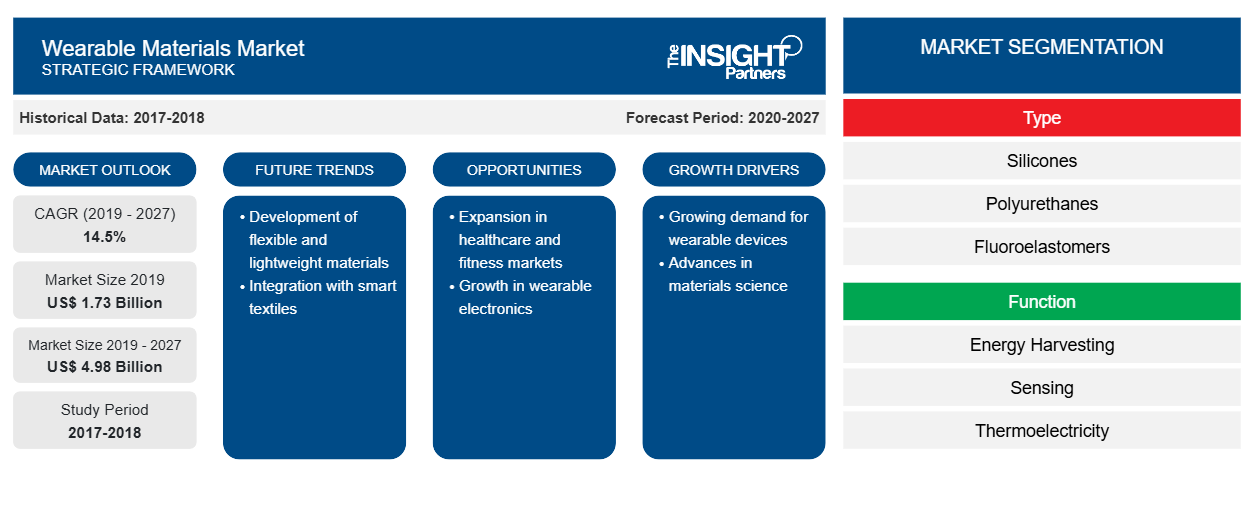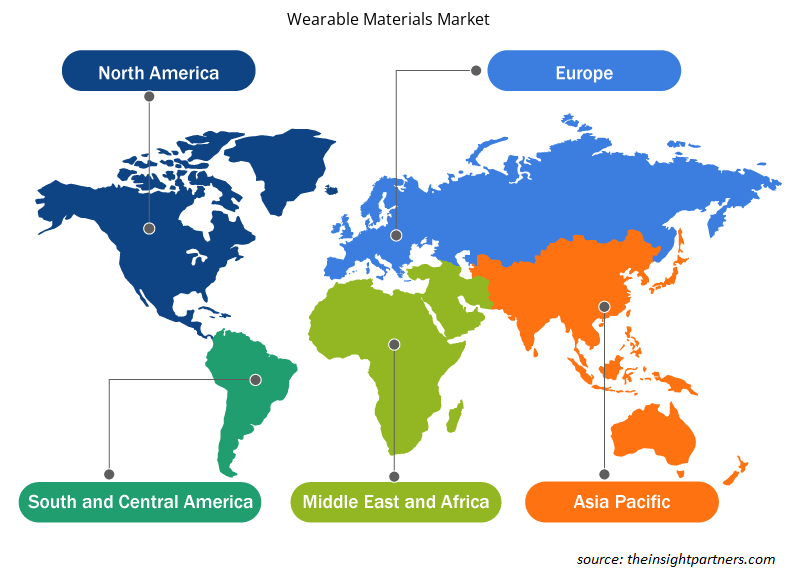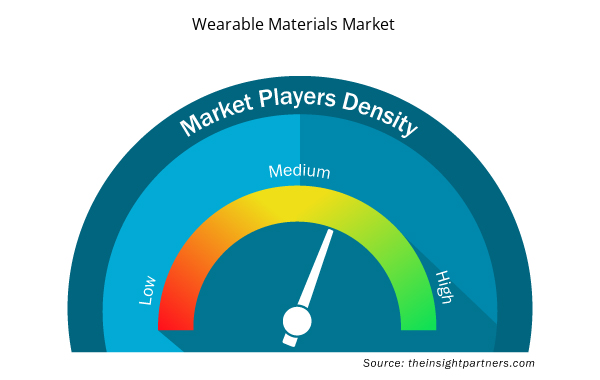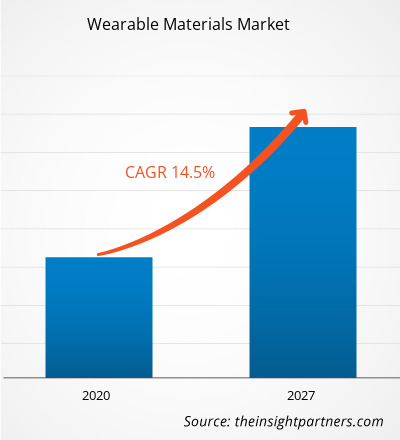The wearable materials market was valued at US$ 1,732.67 million in 2019, it is expected to grow at a CAGR of 14.5% from 2020 to 2027, says The Insight Partners
Wearable materials can be flexibly used in the production of wearable devices and their parts, such as sensors and batteries. These materials possess distinctive characteristic features, including permeability, transparency, adhesion, and processing, along with bio compatibility properties. Moreover, they are quite skin friendly. Increase in adoption of wearable technology has generated a significant amount of demand for materials, which could withstand the wear and tear due to daily usage. Further, such materials are comparatively lighter in weight and are perceived to be comfortable and flexible, thus they find applications across diversified application bases. Such materials are used in the production of fitness bands, smart watches, fitness trackers, and medical devices to gauge the actual body conditions.
In 2019, Asia Pacific was the largest market for wearable materials. The largest market share of the region is primarily attributed to rise in production and consumption of wearable materials in developed and developing economies of Asia Pacific. China is considered to be one of the largest markets where the demand and production of wearable materials is significantly high. The other economies following the growth pattern of wearable materials market include Japan, India, and South Korea. Asia Pacific significantly contributes to the growth of the wearable materials market owing to factors such as rapid urbanization, growing inclination toward technologically advanced products, and rising disposable income. Apart from this, the presence of major manufacturers in the region is substantially driving the growth of the wearable materials market in the region.
The COVID-19 pandemic first began in Wuhan, China in December 2019, and since then, it has spread at a fast pace worldwide. As of September2020, the US, India, Brazil, Russia, South Africa, Mexico, and the UK are among some of the worst affected countries in terms of confirmed cases and reported deaths. The COVID-19 outbreak has been affecting economies and industries in various countries due to lockdowns, travel bans, and business shutdowns. Chemical and materials is one of the major industries suffering facing serious disruptions such as office and factory shutdown, and supply chain breaks, , as a result of this outbreak.
Customize This Report To Suit Your Requirement
You will get customization on any report - free of charge - including parts of this report, or country-level analysis, Excel Data pack, as well as avail great offers and discounts for start-ups & universities
Wearable Materials Market: Strategic Insights

- Get Top Key Market Trends of this report.This FREE sample will include data analysis, ranging from market trends to estimates and forecasts.
You will get customization on any report - free of charge - including parts of this report, or country-level analysis, Excel Data pack, as well as avail great offers and discounts for start-ups & universities
Wearable Materials Market: Strategic Insights

- Get Top Key Market Trends of this report.This FREE sample will include data analysis, ranging from market trends to estimates and forecasts.
Market Insights
Growing Demand for Wearable and Portable Electronic Devices
With the rapid innovation in digitalization and technology and, new wearable gadgets, such as fitness trackers, fitness bands, and smart watches, are being launched that can track the wearer’s movements, heart rate, etc. Many fitness companies have started manufacturing smart running socks which can track the wearer’s running data, such as speed, time, and distance. Most of the wearable materials are made of fabrics such as silicones, which are durable and breathable, and offer other properties, such as better adhesion, permeability, and transparency. Companies are now focusing on designing printed materials for wearable electronics and smart fabrics to meet cost, and versatility.. Several devices, such as Fitbit wristbands, are made of latex-free elastomer material, which is flexible and lightweight.. Many companies and researchers are concentrating on developing smart clothing which can conduct electricity in a better way and is made up of flexible and breathable material. These clothes are produced using special process of electro-spinning which conglomerates the polymer fibers with small silver wires in a liquid form after which it is filtered, dried and heated. These materials can also withstand the wear and tear of daily use. Hence, it is quite evident that the demand for wearable materials would perpetually increase with the surge in demand for wearable devices along with introduction of new and advanced products.
Type Insights
Based on type, the wearable materials market is categorized into silicones, polyurethanes, fluoroelastomers, and others. In 2019, the silicones segment held the largest share in the global wearable materials market. Silicone is a versatile material and it is well known for its permeability, adhesion, peeling, transparency, and biocompatibility properties. Silicones are considered noncytotoxic. They are quite skin friendly with low interfacial bonding and greater flowability for stable adhesion. These materials can be modified according to specific requirements and are, therefore, considered as ideal materials to be used in skin care applications. Furthermore, compared to other organic polymers, silicones are much more breathable and comfortable to wear. Such materials are being used increasingly in the production of wearable medical and consumer electronics devices. These factors further propel the growth of the wearable materials market globally.
Function Insights
Based on function, the wearable materialsmarket is segmented into energy harvesting, sensing, thermoelectricity, luminescent, warming and cooling, and others. The sensing segment led the wearable materialsmarket with the highest market share in 2019. Wearables come in many forms; there are smart wristbands, watches, shirts, shoes, headbands, eyeglasses, and necklaces. Most of them contain sensors that gather raw data and then feed it into a database or software application for analysis. With the growth of wearable devices market, the demand for sensors has significantly gone up.
Application Insights
Based on application, the wearable materials market is segmented into consumer electronics, medical, industrial, and others. The consumer electronicssegment led the wearable materials market with the highest market share in 2019. Consumer electronics is the most extensive application for wearable materials. Wearable consumer electronics include several wearable devices related to fitness & sports, entertainment & multimedia, and garments & fashion. Factors such as growing consumer demand and rapid miniaturization of sensor technology have contributed to the growth of the wearable market, which, in turn, has increased the demand for wearable materials.
Arkema, Momentive, The Lubrizol Corporation, Wacker Chemie AG, Covestro AG, DSM, Solvay S.A, Shin-Itsu, BASF SE, and Dupont are among the key playerspresent in the global wearable materials market. The major players in the wearable materials market are focused on strategies such as mergers and acquisitions and research and development to increase the geographical presence and consumer base globally.
Wearable Materials Market Regional Insights
The regional trends and factors influencing the Wearable Materials Market throughout the forecast period have been thoroughly explained by the analysts at Insight Partners. This section also discusses Wearable Materials Market segments and geography across North America, Europe, Asia Pacific, Middle East and Africa, and South and Central America.

- Get the Regional Specific Data for Wearable Materials Market
Wearable Materials Market Report Scope
| Report Attribute | Details |
|---|---|
| Market size in 2019 | US$ 1.73 Billion |
| Market Size by 2027 | US$ 4.98 Billion |
| Global CAGR (2019 - 2027) | 14.5% |
| Historical Data | 2017-2018 |
| Forecast period | 2020-2027 |
| Segments Covered |
By Type
|
| Regions and Countries Covered | North America
|
| Market leaders and key company profiles |
Wearable Materials Market Players Density: Understanding Its Impact on Business Dynamics
The Wearable Materials Market is growing rapidly, driven by increasing end-user demand due to factors such as evolving consumer preferences, technological advancements, and greater awareness of the product's benefits. As demand rises, businesses are expanding their offerings, innovating to meet consumer needs, and capitalizing on emerging trends, which further fuels market growth.
Market players density refers to the distribution of firms or companies operating within a particular market or industry. It indicates how many competitors (market players) are present in a given market space relative to its size or total market value.
Major Companies operating in the Wearable Materials Market are:
- Arkema
- BASF SE
- Covestro AG
- DSM
- DuPont de Nemours, Inc.
Disclaimer: The companies listed above are not ranked in any particular order.

- Get the Wearable Materials Market top key players overview
Global Wearable Materials Market, by Type
- Silicones
- Polyurethanes
- Fluoroelastomers
- Others
Global Wearable Materials Market, by Function
- Energy Harvesting
- Sensing
- Thermoelectricity
- Luminescent
- Warming and Cooling
- Others
Global Wearable Materials Market, by Application
- Consumer Electronics
- Medical
- Industrial
- Others
Company Profiles
- Arkema
- Momentive
- The Lubrizol Corporation
- Wacker Chemie AG
- Covestro AG
- DSM
- Solvay S.A.
- Shin-Etsu Chemical Co., Ltd.
- BASF SE
- DuPont de Nemours, Inc.
- Historical Analysis (2 Years), Base Year, Forecast (7 Years) with CAGR
- PEST and SWOT Analysis
- Market Size Value / Volume - Global, Regional, Country
- Industry and Competitive Landscape
- Excel Dataset



Report Coverage
Revenue forecast, Company Analysis, Industry landscape, Growth factors, and Trends

Segment Covered
Type , Function , and Application

Regional Scope
North America, Europe, Asia Pacific, Middle East & Africa, South & Central America

Country Scope
Argentina, Australia, Brazil, Canada, China, France, Germany, India, Italy, Japan, Mexico, Russian Federation, Saudi Arabia, South Africa, South Korea, United Arab Emirates, United Kingdom, United States
Frequently Asked Questions
Based on type, why the silicone segment accounted for the largest share in the global wearable material market?
The growth of the silicone segment is primarily attributed to its unique properties such as permeability, adhesion, peeling, transparency, and biocompatibility properties. Silicones are considered non-cytotoxic and are quite skin friendly with low interfacial bonding and greater flowability for stable adhesion. These materials can be modified according to specific requirements and are, therefore, considered as ideal materials to be used in skin care applications.
Can you list some of the major players operating in the globalwearable material market?
The major players operating in the global wearable material market are Arkema, Momentive, The Lubrizol Corporation, Wacker Chemie AG, Covestro AG, DSM, Solvay S.A, Shin-Itsu, BASF SE and Dupont, among others.
Which region held the largest share of the global wearable material market?
In 2018,the wearable material marketwas predominantinAsia Pacificat theglobal level.Rapid urbanization coupled with increase in disposable income and shift in consumer lifestyle are some of the potential drivers facilitating the growth of the wearable material market in the Asia Pacific. Further, the growth of end use industries such as medical and healthcare, automotive, electrical and electronics, and other along with strong presence of leading manufacturers have significantly driven the growth of the wearable material market in the region.
Trends and growth analysis reports related to Chemicals and Materials : READ MORE..
The List of Companies - Wearable Material Market
- Arkema
- BASF SE
- Covestro AG
- DSM
- DuPont de Nemours, Inc.
- Momentive
- Shin-Etsu Chemical Co., Ltd.
- Solvay S.A.
- The Lubrizol Corporation
- Wacker Chemie AG

 Get Free Sample For
Get Free Sample For